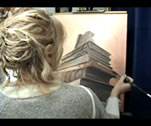This section provides a list of techniques, materials, and common references that are frequently used in the design and decorative painting profession.
This refers to the superb silk or cotton fabrics weaved in Damascus that offer lustrous patterns on a mat background. With the help of stencils, you can recreate on your walls the same contrast between a shiny stenciled design and a mat or satin background. As an additional choice, paint may be replaced by gesso to create a raised pattern. The stenciled design may be stretched with the brush to create a moire or Ikat variation of the damask.
it designates everything beyond a straight coat of paint. It could be a juxtaposition of varied straight coats of paint, diluted paints applied with different tools, artistic paintings covering walls, imitations of materials, metallic paints, uses of plaster mixed with pigments, friezes, stencils, anything that will convey an artistic touch, or simply a detail that will modify the rigor of bare walls, or the enclosed feeling that a cubic room can suggest. Nowadays, art has changed and people are not necessarily seeking beauty but a different look, or an escape to their routine, or to lay a question in an environment where they are ill at ease or unable to deal with.
a technique aimed at aging an object or a surface. There are degrees in this process, ranging from a ravaged look to a soft patina. Most people are fond of this finish because of memories they kept of older and used surroundings of their childhood, in a world where consumerism was absent and where keeping a bare threaded rug or a chipped mug was not a crime but a common choice. Also, when you live in an apartment in the city, a distressed finish is reminiscent of the country look, and brings the reassuring look of nature into your home. Some finishing techniques tend to stage a theatrical and pompous look to impress, whereas distressing leans toward a calming environmental therapy.
They may be the forgotten trump card of your game. Many treatments can embellish them, make them interesting, indeed surprising, with the help of a painted "trompe l'oeil" or a fabric covering. Traditionally, they receive the same treatment as the baseboards, the chair rail and the ceiling cornice or other moldings. However, in a room that counts several, they should have an existence of their own. They can be turned into an art prop, such as a framed print or an object. When a faux wood finish is applied on them, typically it will be flamed mahogany or oak. Frequently they are painted in a "camaieu" of the same shaded color that brings sophistication and softness to them. A geometrical design or ornament can structure the surface and add a visually satisfactory element. Doors should be replaced when a glass door can bring light in, or where a mirror door will widen a space and bring many reflections. If walls are upholstered or faux finished with a silk effect, the doors on the walls could carry the same treatment, for a more refined touch.
this is a faux finish effect obtained by dragging vertically or horizontally a brush, through a wet glaze, from ceiling to floor or wall to wall. The brush imprints regular streaks on the wall, and the finish is similar to a delicate combing of the color on the wall. The base color of the walls still shows through the finish that compliments it by bringing its own hue. It is a rather precious looking finish that goes well with classical or modern interiors. It could be more or less regular; for a more rustic look, you could leave irregular and washed dragging marks. This technique works beautifully with paneled walls.






